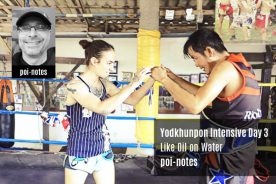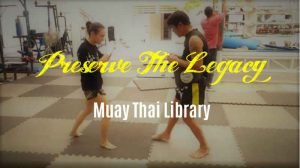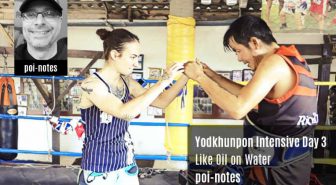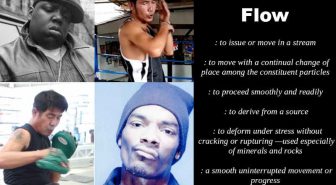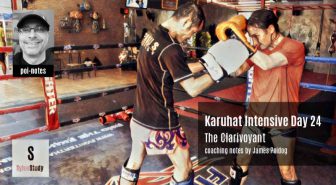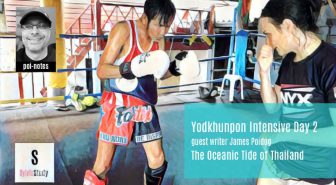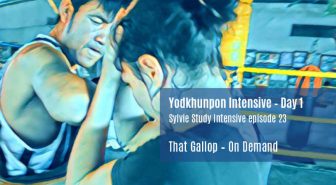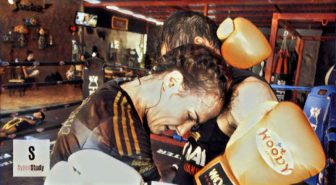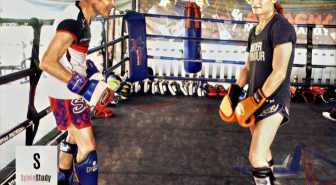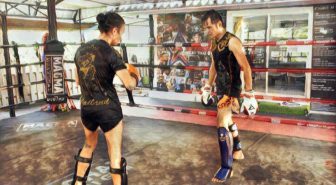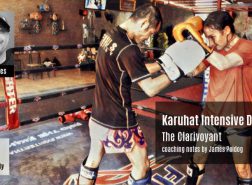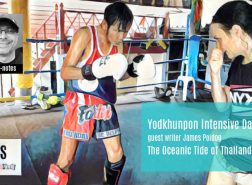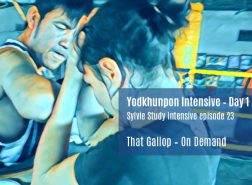poi notes is a coach’s perspective series written by James Poidog, you can find other articles in the series here: poi notes
Like Oil on Water
4 minute preview here – A couple things that are present through out this Intensive session and are immediately apparent are 1) balance being the most important thing and 2) actively using that balance vs passively. In the very beginning there is a sequence where Yod is correcting Sylvie on blocking in vs back; meaning that when checking a kick to stand in a way that meets the kick vs leaning back which creates an imbalance from structure that is enhanced by the incoming force.
This is not only an example of balance being a structural component to fighting but also an example of active vs passive balance. Balancing as an action against a kick vs realizing balance was lost because it wasn’t considered a vital component to checking the kick. He uses the term “stand well” which we can take to mean, be cognizant of your stance, how you stand. All terms for how you balance from the ground up.
I’ll insert a coach’s perspective here too since it was almost at the same time, but the understanding of kicking off the check is I think more important than people realize. There are nuances here that aren’t really always covered at least in the West. Sylvie remarks about not pulling the foot too far back (again a nod to balance) but what goes slightly unnoticed by most, much of the time, is what one needs to sacrifice to achieve the goal. Or better yet, understand what the goal actually is. In repetition kicks on the Thai pad, the goal is to get as many off as you can in a row without loss of balance and usually as quick as you can. Similar to kicking off of the check, which I’d argue the goal is to get your counter off as quick as possible to enhance the chance of landing it cleanly on a target. Pulling the leg too far back, which in this case can be your normal stance width, not only pulls balance away from your target, it takes more time away from your speedy response. A trick few seem to know is understanding that the foot actually comes down and pushes off the ground close to the base leg. You sacrifice power from a deep pull for speed of reaction. You create a better chance to catch your opponent unaware.
And that brings in a point Yodkunpon talks about later in the vlog when they work on elbows and hand positioning for them. He explains that an unaware opponent can’t guard or prepare for whats coming. Its easier to do damage because there’s no resistance to what you are throwing, they cant brace for it. This becomes another huge coach’s perspective for me too because its common to see Western nak muay push down when hand trapping for elbows, to create an avenue for their elbow vs finding an avenue to flow through. Yodkhunpon talks of floating the hand above your opponent’s so when you throw your elbow they aren’t alerted to it right before you fire. It draws attention, at least for me, as to why nak muay are traditionally perceived with hands exaggerated in there positions above the face. Higher hands mean less chance of your opponent reading your movement and avoiding your elbows.
An additional coach’s perspective and one that as a martial arts nerd in general that I am I have to mention; is in when Sylvie talks about the snake head of her hand dictating the perfect position for the elbow, and how not only Yod, but Sagat both use it as a descriptor. Not only does it perfectly illustrate what is needed to be done, but it does it quickly and concisely. I thought of all the animal styles in kung fu and wondered if that’s part of why they existed. Teaching people you learn that the biggest threat to learning is communication. How do I teach something, someone is struggling with? Everyone is familiar with animals. We grew up with animals in some variation; from learning the alphabet to playing with our siblings and friends in the yard. Animals are familiar. Using animals, as illustrated by Yod and Sagat, is a brilliant way to convey information in a way that brings instant clarity.
Getting back to balance and the active vs passive perspective, one of the things that makes Yodkhunpon special is his relentless pressure. In my first write up I called him a relentless tide, a tidal wave if you will. He keeps coming whether a strike lands flush on on the guard, or it misses (in the rare instance that happens). I believe this goes right back to the beginning of the session where he speaks to the “stand well”. He always stand well, so he always has active balance, and so he always can return fire. In the game of kicks til one person stops, the only way to stop him in to catch a kick. Without actively disrupting his onslaught and effectively neutralizing it, you wont get a respite until YOU quit. And if at anytime he chooses to be done with the game, he will easily catch your kick at the perfect moment and forcefully remove your balance in a way that drops you and shows everyone exactly how dominant he really is.
Sylvie Study guest writer – James Poidog
You can find James on Facebook, at his gym Kaiju MMA & Fitness, or follow him on Instagram
*******
This is Sylvie Study Episode 26, you can see it On Demand here. At top is a free 4 minute extended clip from the session James is talking about in this post, but you can watch the full 56 minute commentary video of this session on Vimeo On Demand. Purchase of the video or subscription lends support to legends of the ring as the krus gets 55% of the net proceeds from this series, distributed; patrons get a substantial discount for these purchases so check that out (you can purchase Episode 26 individually after the trailer below, or look to Episode 26 in the full list). You can also subscribe to the entire series, there are now over 36 hours of commentary training footage published, featuring in depth study of legends:
Read about and check out GIFs from Day 1 with Yodkhunpon here.
watch all the free videos in this Sylvie Study series

